Roland, Tom, and colleagues Max Joseph (Planet, CU Boulder ), Mark Wilber (U. Tennesee), and Rob Grasso (Yosemite National Park) are celebrating new work just published in Nature Communications! This article synthesizes decades of frog recovery work, including frog translocations, capture-mark-recapture population studies, disease quantification, and mathematical modeling. Take away: frogs in Yosemite have adapted to live with Batrachochytrium dendrobatidis, and that evolution can be leveraged to facilitate recovery on a landscape scale. Read the full article here:
https://www.nature.com/articles/s41467-024-53608-4

This article has captivated the press. Here are some examples:
– UCSB press release
– USA Today
– San Francisco Chronicle
This tremendous effort would not have been possible without our amazing field teams over the past two decades, and the recent support of Alexa Lindauer managing our laboratory and data! Thanks everyone!












